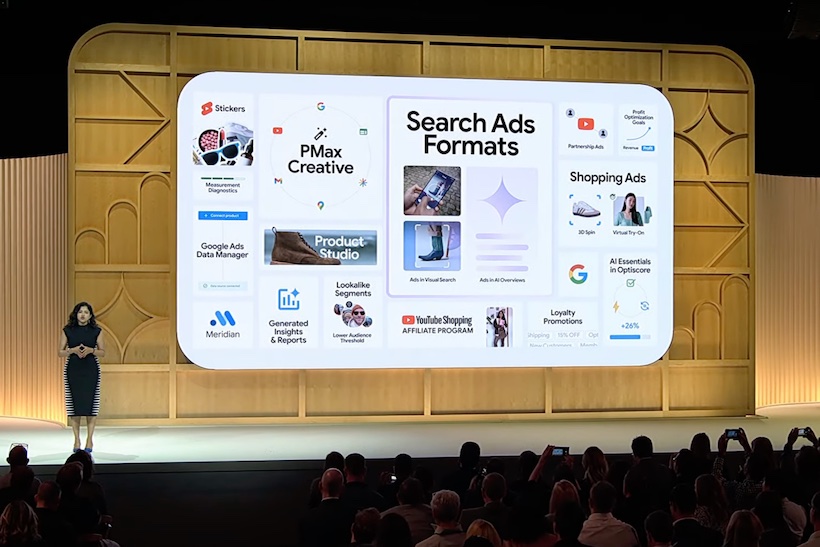Google announced a slew of new and updated AI-powered advertising products during its annual marketing event on Tuesday alongside greater controls, as advertisers try to protect their brand identities in an increasingly automated industry.
Shopping ads got several updates at Google Marketing Live. Merchants can now automatically create 3D versions of their products from images taken at different angles; short-form videos of products can be integrated into ads alongside AI summaries; and apparel ads for men’s and women’s tops can offer users a virtual try-on option.
Google launched its virtual try-on tool in July last year with retailers Anthropologie, Everlane, H&M and Loft, and is now opening the tool up to advertisers.
To facilitate the creation of more “more on brand” content within Product Studio, which houses Google’s AI-powered asset generation tools, advertisers can now upload a brand reference asset to be used alongside text prompts when generating different product scenes. A new capability can animate components of a still product image to create a short video or GIF.
Assets created through Product Studio are owned by the merchant and can be used within Google ads or downloaded for use outside of Google properties.
Google is also experimenting with search ads that integrate its AI capabilities. It is conducting a “very small test” in the U.S. over the next few weeks of a new ad format in which consumers can click to open up an interactive experience, where they can upload photos to receive AI-powered recommendations related to the advertised service. An example was shared of uploading photos of furniture on an ad by Extra Space Storage to receive a recommended storage unit size.
The AI-powered search ads are in “really early days” and have not been tested by any other advertisers yet, said Rachel Melgaard, director of global search ads, during a press briefing ahead of GML.
Elsewhere in search, Google is continuing to test ads that appear within or adjacent to the AI-powered summarized responses now appearing at the top of many Google searches.
The conversational AI overviews, generated by Google’s Gemini model, were rolled out to U.S. users last week following a year of testing. Since they push traditional link-based search results down the page, there are concerns the overviews could be damaging to publishers.
The new search experience is also changing how ads appear. Google said Tuesday it is conducting a “small test” of ads shown above, within or below the AI overviews for U.S. users in the coming weeks. The ads, which would be marked in a “sponsored” section, could either be search or shopping ads and would be relevant to a user’s query.
It shared an example of a carousel of shopping ads for wrinkle release sprays, which appeared underneath a query asking about how to remove wrinkles from clothes without an iron.

This is not the first round of tests: Google has been testing ads within its AI-powered search experience, previously called Search Generative Experience, since it announced the product at its Google I/O annual developer conference in 2023. What’s new is the search experience has moved from its Search Labs to be live on Google.com.
Advertisers who purchase search, shopping or Performance Max campaigns cannot opt out of appearing within the AI overview, but Google will honor an advertiser’s existing controls such as keyword blocklists, said Melgaard.
Though the tech company did announce new controls in Performance Max, Google’s automated campaign format that has come under heat in the past year for a lack of transparency, leading to damaging placements slipping under the radar.
Report: Google brokered search ads on piracy, porn and sanctioned foreign sites
Google began offering impression-level placement reporting of Search Partner Network sites for Performance Max campaigns earlier this year following Adalytics’ damning report about the third-party network placing ads on illicit sites, which caused some advertisers to pull spend.
On Tuesday, it announced it would add placement reporting and exclusions for YouTube videos as well as asset-level reporting so advertisers can track conversion metrics for each piece of creative.
“It’s hard to fully trust what you can’t also verify — that’s why we’re launching additional reporting and controls in PMax,” said Tim Frank, senior director of product management, on stage at GML.
Performance Max is also getting more creative controls.Advertisers will “soon” be able to share their brand guidelines, such as their fonts and colors, alongside image reference points within the Performance Max platform so any assets generated remain “on brand,” said Josh Moser, a Performance Max product manager, at the press briefing.
Keeping generated assets “on brand” was mentioned several times throughout the press briefing, suggesting that brand consistency can be challenging to control within AI creations.
Amidst growing scrutiny towards AI and its impact on creative industries, Google was careful to acknowledge the limits of the technology at GML. Google Ads VP and general manager Vidhya Srinivasan emphasized to advertisers and agencies in the audience that AI “is not a marketer.”
At SXSW, creatives and technologists clashed over AI
“AI doesn’t have taste, it doesn’t have ingenuity,” she said. “And then when it comes to advertising, it just does not have your creativity, your strategic insights, your expertise. These will always always be your advantage. But AI can help, and will help.”

